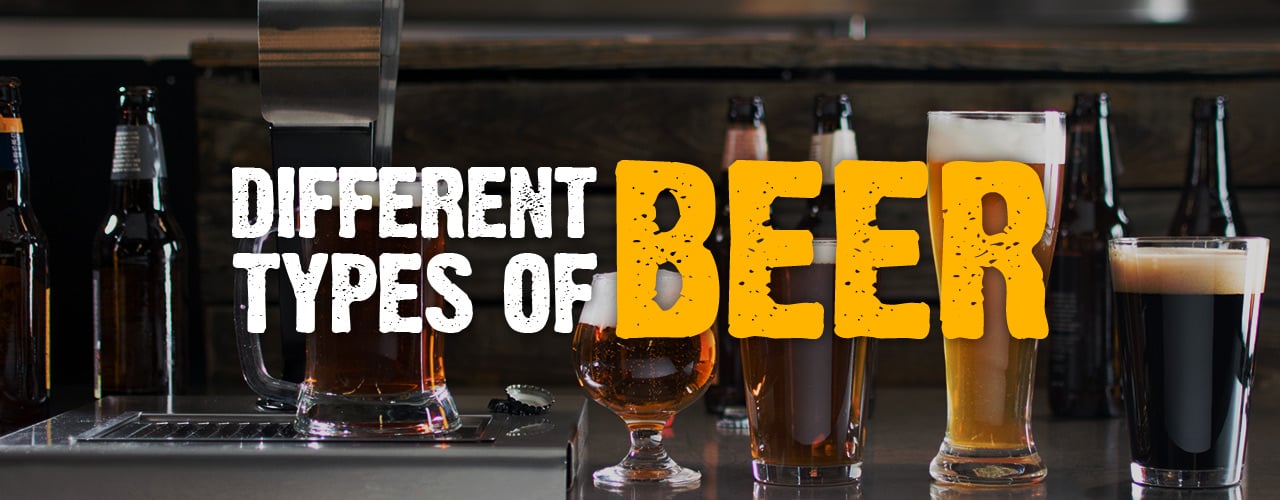
Top 10 Styles of Beer
Last updated on 5/7/2024Beer is one of the oldest and most widely consumed alcoholic beverages in the world, with over 9,000 craft breweries in the U.S. alone. Gaining an understanding of the different types of beer available can be the key to success if you’re planning to start your own brewery. From their unique flavor profiles and food pairings, we’ll break down the most popular beer types so you can make recommendations and create a beer list your customers will love.
Shop All Brewery EquipmentAles vs Lagers
There are two main categories of beer - ales and lagers. The difference between ales and lagers comes down to their temperature and fermenting yeast. Ales are brewed at warmer temperatures than lagers with top-fermenting yeast, typically between 60-75 degrees Fahrenheit. This results in a faster fermentation process, which imparts a more complex flavor profile that can range from fruity and spicy to bitter and hoppy. Most craft beers will have ales as their base because of the rapid fermenting and ease of temperature control.
Lagers are known for their crisp, clean taste and are typically brewed at cooler temperatures, around 45-55 degrees Fahrenheit, using bottom-fermenting yeast. Lagers are known for their smooth and refreshing qualities, making them popular choices for easy-drinking beers in the summer. While ales and lagers differ in brewing techniques and flavor profiles, both types of beer offer a wide range of options for consumers and businesses alike.
ABV vs IBU
ABV, or alcohol by volume, measures the alcohol content in beer and is expressed as a percentage. It indicates the strength of the beer and can range from 3% in light beers to over 10% in stronger brews. IBU, or International Bitterness Units, measures the bitterness of beer from hops and is a scale that typically ranges from 0 to 100 or more. The ABV and IBU of a beer can help determine its flavor profile and balance, with higher ABV beers often having more intense flavors and higher IBU beers being more bitter.
Types of Beer
When it comes to choosing the right beer for your establishment, it's essential to understand the various types available to cater to different preferences and occasions. From bold and hoppy IPAs to rich and creamy stouts, the world of beer offers a diverse array of options to suit every palate. We’ll explore the top 10 styles of beer to help you choose the ones that are best for your business.
1. IPA
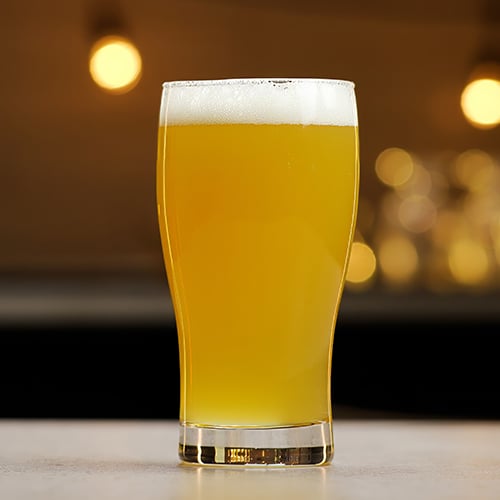
IPA, or India Pale Ale, is a popular beer style known for its bold hop flavors and aromas. This style originated in England in the 19th century and has since evolved into various subcategories, including American IPA, Double IPA, and New England IPA. One defining characteristic of IPAs is their high hop bitterness, which provides a distinct and often intense floral, citrus, or piney flavor profile. This bitterness is balanced by a strong malt backbone, creating a harmonious blend of flavors that appeals to many beer enthusiasts.
American IPAs are typically more hop-forward than their English counterparts. These beers often have a higher alcohol content and a more pronounced bitterness, making them a favorite among craft beer aficionados looking for a bold and flavorful drinking experience. Double IPAs, also known as Imperial IPAs, have an even higher alcohol content and hop additions. This creates a more robust and complex flavor profile that can range from resinous and dank to tropical and fruity. New England IPAs are characterized by their hazy appearance and creamy mouthfeel. These beers are known for their low bitterness and intense hop aroma, perfect for those seeking a softer and more approachable IPA experience.
- IPA ABV: 5.0-14.0%
- IPA IBU: 30-100
- Types of IPAs: American IPA, Imperial or Double IPA, English IPA
- IPA Brands: Dogfish Head 60 Minute IPA, Russian River Brewing Company's Pliny the Elder, Goose Island India Pale Ale
- IPA Pairings: American cuisine, Indian cuisines, fish, sharp cheeses
- IPA Serving Temperature: 45-50 degrees Fahrenheit
2. Stout
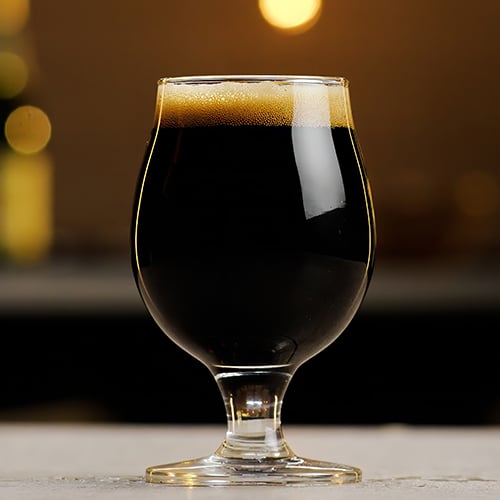
Stout is a dark, rich beer known for its robust flavors and creamy mouthfeel. Originating in the United Kingdom, stout has gained popularity worldwide for its distinctive color and smooth finish. Stouts feature mid-to-high alcohol levels and pair well with a variety of foods, including hearty dishes like roasted meats, stews, and rich desserts. One of the most well-known types of stout is Irish dry stout made popular by Guinness. This style is characterized by the visual cascading effect in the glass and its dry, roasted malt flavors with hints of coffee and chocolate.
Another popular variation is the oatmeal stout. These are brewed with oats, which contribute to a smooth, silky mouthfeel. Oatmeal stouts have a rich, full-bodied flavor with notes of roasted coffee, chocolate, and sometimes a hint of sweetness. They are popular for their complexity and drinkability. Imperial stout, on the other hand, is a bold and intense variation of the stout style. This beer is characterized by its high alcohol content, rich malt flavors, and complex aromas. Imperial stouts often feature notes of dark fruits, roasted coffee, and bittersweet chocolate.
- Stout ABV: 3.8-8.9%
- Stout IBU: 20-60
- Types of Stouts: Irish Dry Stout, Oatmeal Stout, American Imperial Stout
- Stout Brands: Guinness Draught, Troegs JavaHead Stout, Stoudts Fat Dog Imperial Stout
- Stout Pairings: Heavy foods like beef and stew, oysters, chocolate, brie cheese
- Stout Serving Temperature: 45-55 degrees Fahrenheit

3. Porter
Porter is a dark and robust style of beer with a rich history dating back to the 18th century in England. Originally popular among the working class, this beer has since evolved into a beloved style among beer enthusiasts worldwide. Similar to stout, porter is characterized by its deep brown-to-black color. The way porter differs from stout is that it uses malted unroasted barley instead of unmalted roasted barley. This gives porter its complex flavor profile that often includes notes of caramel, toffee, and dark fruit, making it less intense than stout.
American imperial porter is a bold and robust variation of the traditional porter style. Known for its higher alcohol content and intense flavors, this beer often features rich notes of roasted malt, chocolate, and coffee. English brown porter offers a more moderate take on the porter style, with a balanced flavor profile that showcases the beer's malt character, creating a smooth and easy-drinking experience. Robust porter strikes a harmonious balance between the two, with a medium-to-full body and a robust malt presence. This style is known for its smooth mouthfeel and well-rounded flavor profile.
- Porter ABV: 4.5-12.0%
- Porter IBU: 20-50
- Types of Porters: American Imperial Porter, English Brown Porter, Robust Porter
- Porter Brands: Sierra Nevada Brewing Company Porter, Shipyard Longfellow Winter Ale, Smuttynose Robust Porter
- Porter Pairings: American cuisine, English cuisine, barbecue, tiramisu, asiago cheese
- Porter Serving Temperature: 40-55 degrees Fahrenheit
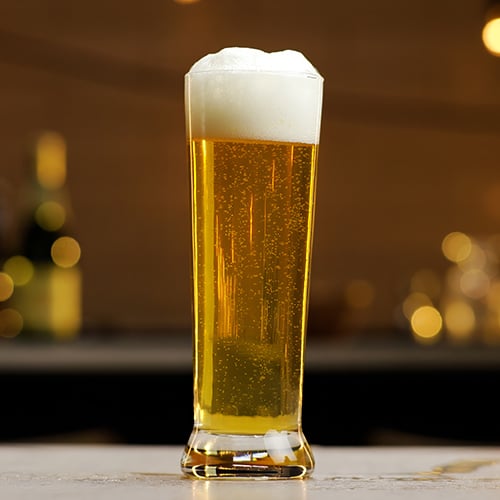
4. Pilsner
Pilsners are light, crisp lagers with a clean, refreshing taste. They are known for their golden color and balanced bitterness. This style of beer became popular in what is now the Czech Republic and Germany. They are perfect for hot summer days or as a palate cleanser between courses. The classic American lager is a type of pilsner that is widely consumed in the United States. This beer is light-bodied, with a clean and crisp taste that makes it a go-to choice for many beer drinkers for celebrations like Mardi Gras.
German Pilsner, also known as pils or pilsener, is characterized by its pale golden color, floral hop aroma, and balanced bitterness. German pilsners are traditionally brewed using noble hops, which give the beer a subtle yet complex flavor profile. Czech or Bohemian pilsner is another popular variation of pilsner known for its rich malt character, spicy hop aroma, and crisp finish. Czech pilsners are brewed using Saaz hops, which impart a distinctive herbal and earthy flavor to the beer.
- Pilsner ABV: 3.2-5.6%
- Pilsner IBU: 15-45
- Types of Pilsners: American Lager, German Pilsner, Czech or Bohemian Pilsner
- Pilsner Brands: Budweiser, Troegs Sunshine Pils, Dogfish Head Piercing Pils
- Pilsner Pairings: German cuisine, spicy food, poultry, fish, spicy cheese
- Serving Temperature: 40-45 degrees Fahrenheit
5. Wheat Beer

Wheat beer is a popular style of beer made by using wheat as the malt, giving the beer its signature refreshing and crisp taste. With its tangy flavors, brewers often add seasonal fruits to wheat beer to create an enticing presentation. American pale wheat beer is a light and easy-drinking beer that is brewed with a significant proportion of wheat in addition to barley. This style is known for its pale color, mild hop bitterness, and subtle wheat flavor, making it a popular choice for those looking for a refreshing and approachable beer.
Berliner Weisse is a traditional German wheat beer that is known for its light body and high carbonation. This style is typically low in alcohol content and is often served with a flavored syrup, such as raspberry or woodruff, to balance out the sourness of the beer. Hefeweizen is a classic German wheat beer that is brewed with a large proportion of wheat and a distinctive yeast strain that produces flavors of banana and clove. Hefeweizens are known for their cloudy appearance, full body, and effervescent carbonation. This style of wheat beer is often unfiltered, allowing the yeast to remain in the beer and contribute to its unique flavor profile.
- Wheat Beer ABV: 2.8-5.6%
- Wheat Beer IBU: 3-35
- Types of Wheat Beers: American Pale Wheat, Berliner Weisse, Hefeweizen
- Wheat Beer Brands: Blue Moon Summer Honey Wheat, Freetail Brewing Company Yo Soy Un Berliner, Magic Hat Circus Boy
- Wheat Beer Pairings: German cuisine, Mexican cuisine, spicy food, seafood, brick cheeses
- Wheat Beer Serving Temperature: 45-50 degrees Fahrenheit
Back to Top
6. Pale Ale

Pale ale is a popular beer style known for its balanced flavors, offering a mix of hoppy bitterness and malt sweetness. They are lower in alcohol content than IPAs and pair well with a wide range of dishes. American pale ale is a hop-forward beer with a moderate malt backbone. It typically features American hop varieties that impart citrus, pine, and floral notes to the brew. These ales are known for their refreshing bitterness and bright aromatics.
Blonde ale is a lighter and more delicate version of pale ale, with a focus on crisp, clean flavors. They are characterized by their pale golden color and subtle malt sweetness. These beers are easy-drinking and versatile, making them a popular choice for those new to craft beer or looking for a lighter option. English pale ale is a classic beer style with a rich malt profile and earthy hop character. They often showcase traditional English hop varieties, which creates a balance between bitterness and biscuity malt flavors.
- Pale Ale ABV: 4.0-5.5%
- Pale Ale IBU: 15-45
- Types of Pale Ales: American Pale Ale, Blonde Ale, English Pale Ale
- Pale Ale Brands: Smuttynose Shoals Pale Ale, Victory Brewing Company Summer Love, Flying Fish Extra Pale Ale
- Pale Ale Pairings: Italian cuisine, English cuisine, fish, fried foods, pepper jack cheese
- Pale Ale Serving Temperature: 35-45 degrees Fahrenheit
7. German Bock
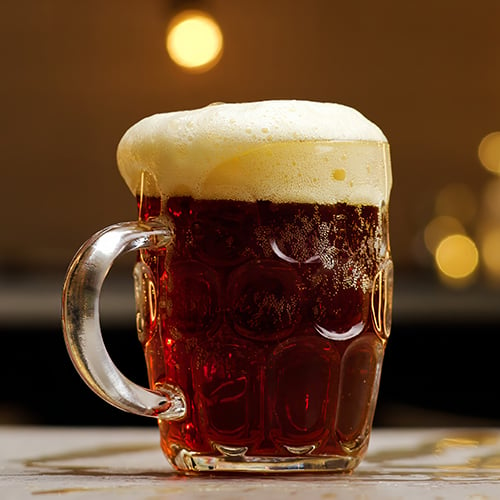
Bock beer is a traditional German style that has gained popularity worldwide for its rich malt character and robust flavors. They are higher in alcohol content and can range from pale to dark in color with notes of caramel and toast. This style is often enjoyed as a winter beer for its warming qualities and pairs well with rich and savory foods. Traditional bock is a strong lager known for its malty sweetness and deep amber-to-dark brown color.
Weizenbock is a wheat bock beer that combines the characteristics of a traditional bock with the fruity and spicy notes of a wheat beer. It is known for its hazy appearance and complex flavor profile, which includes banana, clove, and bubblegum notes from the yeast strain used during fermentation. Maibock, also known as Helles bock, is a pale bock beer that is lighter in color and body compared to traditional bock. Maibock is brewed with a higher proportion of pale malts, giving it a clean and crisp profile with a noticeable malt sweetness. This style of bock beer is often brewed in the springtime and enjoyed during the month of May, making it the perfect addition to any beer garden.
- Bock ABV: 6.0-9.5%
- Bock IBU: 15-35
- Types of Bock Beer: Traditional Bock, Weizenbock, Maibock
- Bock Beer Brands: Samuel Adams Winter Lager, Southern Tier Brewing Company Goat Boy, Capital Brewery Maibock
- Bock Beer Pairings: Italian cuisine, German cuisine, fish, shellfish, asiago, Swiss cheese
- Bock Beer Serving Temperature: 40-50 degrees Fahrenheit
8. Brown Ale

Brown ale is a malt-forward beer with a deep amber-to-dark brown color and flavors of caramel, nuts, and toffee. This style is smooth and easy to drink, making it a great option for customers looking for a more approachable beer. English brown ale, also known as Northern English brown ale, is known for its malt-forward profile, showcasing toasty, biscuity, and caramel flavors with minimal hop bitterness. English brown ales are typically lower in alcohol content and have a lighter body compared to the American style, offering a smooth and easy drinking experience.
American brown ale is a modern take on the traditional English brown ale, characterized by a balanced flavor profile that combines malty sweetness with moderate hop bitterness. This style typically features a medium body and a slightly higher alcohol content compared to its English counterpart. American brown ales often showcases notes of caramel, chocolate, and nutty flavors, making them a favorite among craft beer enthusiasts.
- Brown Ale ABV: 4.0-6.3%
- Brown Ale IBU: 15-45
- Types of Brown Ale: English Brown Ale, American Brown Ale
- Brown Ale Brands: Newcastle Brown Ale, City Star Brewing Bandit Brown, Brooklyn Brewery Brown Ale
- Brown Ale Pairings: American cuisine, beef stew, red meat, poultry, gouda cheese
- Brown Ale Serving Temperature: 40-50 degrees Fahrenheit
9. Belgian Ale
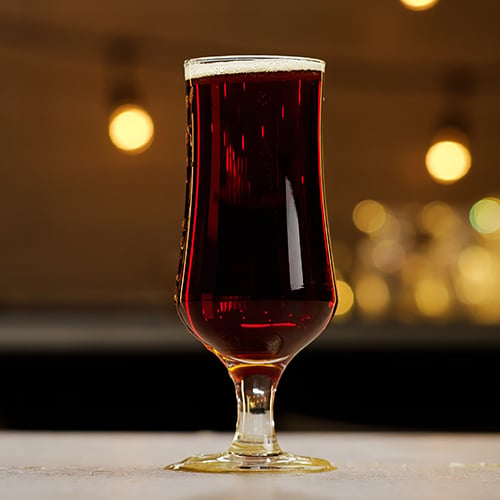
Belgian beers are known for their spiced fruity flavors and high alcohol content. Despite their high ABV, Belgians are usually low in bitterness. Belgian-style ale encompasses a wide range of styles, from fruity and spicy to complex and yeasty ales. These beers are often brewed with unique yeast strains, resulting in distinctive flavors, aromas, and high carbonation.
Belgian pale ale is a style known for its balanced maltiness and hop bitterness. It typically features fruity esters and spicy notes, with a moderate alcohol content. Belgian tripel is a strong ale with a higher alcohol content compared to other Belgian styles. It is characterized by its pale color, complex malt profile with a dry finish, and effervescent carbonation. Belgian saison, also known as farmhouse ale, is a rustic beer style that originated in the French-speaking region of Belgium. Traditionally brewed in the winter months for consumption in the summer, saisons are known for their fruity and peppery yeast character and dry finish.
- Belgian Ale ABV: 4.4-10%
- Belgian Ale IBU: 20-50
- Types of Belgian Ale: Belgian Pale Ale, Belgian Tripel, Belgian Saison
- Belgian Ale Brands: Samuel Adams Belgian Session, Weyerbacher Merry Monks, Victory Brewing Company Helios
- Belgian Ale Pairings: American cuisine, Asian cuisine, pasta dishes, barbecue, meat, Limburger cheese
- Belgian Ale Serving Temperature: 45-55 degrees Fahrenheit
10. Specialty Beer
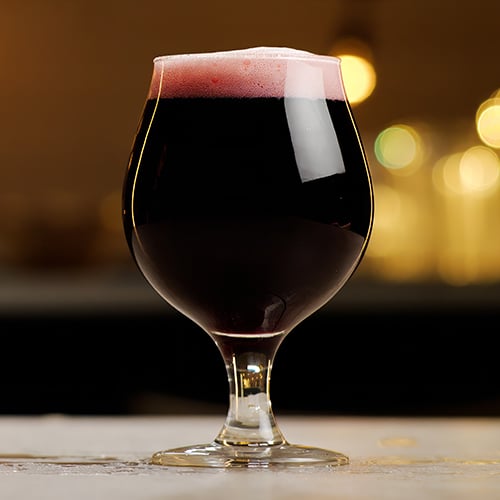
Specialty beers offer unique and diverse options for beer enthusiasts, catering to a range of tastes and preferences. From experimental brews to niche flavors, there is a specialty beer for every palate. These beers can range from barrel-aged beers to sour ales, from fruit-infused beers to spiced variations, offering customers a chance to try something new and exciting.
Sour ales are a distinctive type of beer known for their tart and acidic flavors. These beers are fermented with specific strains of yeast and bacteria, resulting in a sour and tangy taste profile that sets them apart from traditional ales. Another specialty beer is gluten-free beer. They are brewed using alternative grains such as sorghum, millet, or rice to create a beer that is safe for individuals with gluten sensitivities or celiac disease.
Spruce up your beer menu with crowd-pleasing flavors of beer that you can rotate throughout the seasons. Pumpkin beer is a seasonal favorite that typically makes its appearance during the fall months. Brewed with pumpkin puree and a blend of spices like cinnamon, nutmeg, and cloves, pumpkin beer offers a festive and flavorful twist on traditional beer styles. Chocolate beer is a decadent and indulgent option for those with a sweet tooth. Brewed with chocolate malt or actual cocoa nibs, these beers offer a rich and velvety flavor profile that is reminiscent of a chocolate dessert, perfect for Valentine’s Day. Whether you're looking to explore new flavor profiles or indulge in a seasonal favorite, specialty beers offer a diverse and exciting range of options for beer enthusiasts to enjoy.
- Specialty Beer ABV: 3-10% or over
- Specialty Beer IBU: Varies
- Types of Specialty Beer: Sour Ales, Gluten Free Beer, Pumpkin Beer, Chocolate Beer
- Specialty Beer Brands: Dogfish Head Beer SeaQuench Ale Session Sour, Wicked Weed Brewing Gluten FREEk, Elysian Brewing Company Night Owl Pumpkin Ale, Yuengling Hershey’s Chocolate Porter
- Specialty Beer Pairings: Varies
- Specialty Beer Serving Temperature: Varies
Cooking with Beer
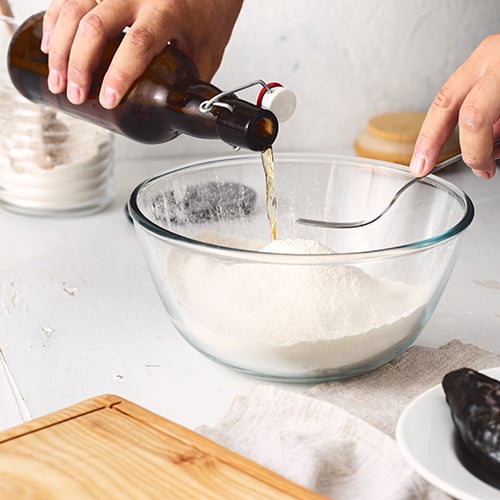
Beer is a versatile ingredient that can add depth and complexity to a wide range of dishes, from soups and stews to desserts and dressings. When used in cooking, beer can impart unique flavors, enhancing the overall taste profile and texture. Here are just some beers you can use in the kitchen:
- IPA: IPAs are characterized by their hoppy bitterness and floral aromas, making them a bold choice for marinating meats or adding to cheese sauces. The intense flavors of IPAs can infuse dishes with a complex and aromatic profile, making them a popular choice for battered beer fish or shrimp.
- Wheat Beer: Wheat beers have a light and citrusy profile that is perfect for cooking seafood or incorporating into salad dressings. The bright and refreshing notes of wheat beers can add a subtle tanginess to dishes, enhancing the overall taste experience.
- Stout: Stout beers are known for their bold roasted malt flavors which are excellent for braising meats or adding depth to chocolate desserts. The rich and complex flavors of stouts can elevate dishes like beef stew or chocolate cake, creating a decadent and satisfying meal.
When cooking with beer, it is important to consider the alcohol content and flavor profile of the beer to ensure it complements the other ingredients in the dish. Experimenting with different types of beer can help you discover new and exciting ways to enhance your culinary creations with the diverse flavors of this beloved beverage.
Back to Top
From popular lagers and ales to unique stouts and porters, there is a wide range of beer types to help you cater to your customer preferences. By knowing the characteristics and flavors of each type of beer, you’ll be able to enhance your beverage menu and provide a memorable experience for your patrons. Once you have narrowed down your options, pair your menu with the right beer glasses for each beer type.






